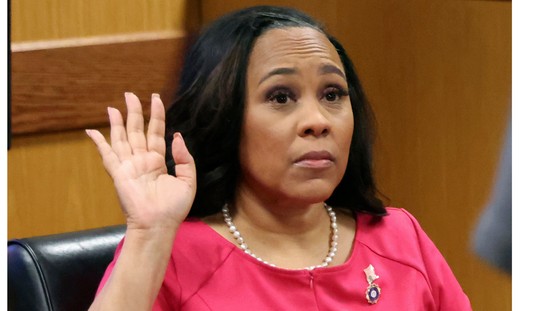Those denials by Hillary Clinton look pretty ragged after the most recent release of e-mails from her secret server — and more than just the New Media have noticed. The Washington Post’s Carol Leonnig and Rosalind Helderman count up at least six e-mails in this tranche that originated with the former Secretary of State that contain classified information. That “appears to contradict” Hillary’s categorical denials of having personally sent any classified information through the unsecured and unauthorized home-brew e-mail system, they write:
Although government officials deemed the e-mails classified after Clinton left office, they could complicate her efforts to move beyond the political fallout from the controversy. They suggest that her role in distributing sensitive material via her private e-mail system went beyond receiving notes written by others, and appears to contradict earlier public statements in which she denied sending or receiving e-mails containing classified information.
The classified e-mails, contained in thousands of pages of electronic correspondence that the State Department has released, stood out because of the heavy markings blocking out sentences and, in some cases, entire messages.
The State Department officials who redacted the material cited national security as the reason for blocking it from public view.
The State Department tried offering an out to the Clintons, but the Post’s reporters aren’t quite buying it:
State Department spokesman John Kirby said that “classification is not always a black-and-white, binary judgment. Responsible people can draw different conclusions.”
But the presence of classified information in e-mails Clinton wrote appears to contradict her assurances that she sent no such material.
For everyone else, the notion that compliance with classification isn’t “binary” would be ludicrous. You either comply with classification protocols or you get fired, you lose your clearance, and in some cases you get prosecuted. Individual users don’t get to pick and choose which items they believe should and should not be classified. Only the originating agency gets to make that choice, and even then declassification procedures have to take place before information is in the clear.
On top of that, the classification dates applied by State in these documents show that they considered the information classified at the moment the e-mail was created. These are not retroactively classified in the sense that data that was once in the clear has suddenly become too sensitive for public dissemination since. In fact, common sense would inform people that such retroactive classifications would be extremely rare if they ever take place at all.
Yet Hillary wants to keep pushing that notion, as she did last week in the DNC’s summer meetings:
“I have said repeatedly that I did not send nor receive classified material, and I’m very confident that when this entire process plays out that will be understood by the everyone,” she said last week during a Democratic Party meeting in Minneapolis. She said that government officials may now be making different determinations after the fact, but “it does not change the fact that I did not send, nor receive, material marked classified.”
“Marked classified” is another deception. Information is classified; the material in which it appears has to be marked with its classification level, but a lack of marking does not make information unclassified. Hillary took classified information and sent it out unmarked in an unauthorized and unsecured communications system.
Andy McCarthy explained earlier that existing executive orders made clear that this kind of diplomatic information was considered classified from its conception at all times. Another e-mail shows Hillary Clinton ordering aide Jake Sullivan to take classified information from the secure government server and retransmit it to her private e-mail account, which Sullivan refuses to do, at least in this instance. McCarthy points out that this reveals the gross negligence and reckless disregard for national security under which Hillary operated:
The classification rules in government can be very frustrating, and too much information is restricted. But this is because, from a national-security standpoint, it is better to classify something that is of dubious importance (especially because, as I explained earlier, it is crucial to demonstrate to foreign governments that we can keep secrets if we want them to tell us secrets) than to risk the disclosure of information that can put Americans at risk if it falls into the wrong hands. The important point here is that it is usually the unseasoned subordinate officials who are anxious to bend the rules when they seem unduly burdensome. It is the adult supervisor who must then uphold the rules for the greater good. In this case, though, it is Sullivan, the subordinate, who must (gently) remind Clinton, the rash boss, that classified information must be handled appropriately.
The second point is that this concretely demonstrates something I’ve been hammering since Mrs. Clinton’s March press conference: the difference between classified documents and classified information. In the government, classified documents are kept in a separate, hyper-protected system. It is thus extremely difficult (impossible for most users) to access them from a non-classified e-mail system and then to transmit them over that non-classified system. Most people do not know this.
This is why it was a red herring for Clinton to stress back in March that she had never kept “classified documents” on her private e-mail system. As I countered at the time, “In general, Mrs. Clinton would not have been able to access classified documents even from a ‘.gov’ account, much less from her private account — she’d need to use the classified system.” The issue is not classified documents; it is whether Clinton sent, received, and stored the classified information that was in the documents (or was orally explained in classified briefings). The above exchange demonstrates what I have been talking about: Sullivan tells Clinton that, at that moment, he is unable to send her the classified information she is demanding because he cannot even physically access the document that contains it — i.e., the document is available only in the government’s classified system which, at that moment, he is unable to get into (because, I would guess, he is not physically near it).
Clinton not only ordered aides to put classified information on an unclassified (and unsecured, and unauthorized) system, she did so herself on at least six occasions. The classified information wasn’t marked because Hillary and her team didn’t mark the data when they manipulated it. Only now, when the State Department has seen these e-mails for the first time, can they properly mark and redact the information that went out in the clear, open to hackers, and on at least one occasion sent to a private citizen with no apparent clearance and certainly no need to know (Sidney Blumenthal).
Had anyone whose name did not rhyme with Millary Minton operated in such a systemic manner to disregard national-security protocols and send out classified material to unauthorized persons, they would need a good lawyer to minimize their prison time. Do we have one law for the ruling elite and another for those who toil in service to them? We will shortly find out.








Join the conversation as a VIP Member